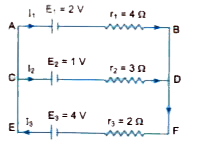State Markownikov's rule. Using this rule, write the reaction of propene with
H2O
Step-by-Step Solution:
1. State Markovnikov's Rule:
Markovnikov's rule states that in the addition of HX (where X is a halogen or hydroxyl group) to an alkene, the hydrogen atom (H) will attach to the carbon atom that has the greater number of hydrogen atoms already attached. In other words, the more substituted carbon atom will receive the electrophile, while the less substituted carbon will receive the nucleophile.
2. Identify the Reactants:
We are considering the reaction of propene (C3H6) with water (H2O). Propene has the structure:
CH3−CH=CH2
3. Add Water in the Presence of Acid:
The reaction of propene with water typically occurs in the presence of a dilute acid, such as dilute sulfuric acid (H2SO4). This acid helps to protonate the alkene.
4. Apply Markovnikov's Rule:
According to Markovnikov's rule, the hydrogen from water will add to the carbon atom of propene that has more hydrogen atoms. In propene, the carbon atoms are as follows:
- Carbon 1 (C1) has 3 hydrogen atoms (CH3)
- Carbon 2 (C2) has 1 hydrogen atom (CH)
- Carbon 3 (C3) has 2 hydrogen atoms (CH2)
Since C1 has the most hydrogen atoms, the hydrogen from water will attach to C1.
5. Determine the Product:
After the addition of H2O, the hydroxyl group (OH) will attach to the carbon atom with fewer hydrogen atoms (C2). Therefore, the product of the reaction will be:
CH3−CHOH−CH3(which is propan-2-ol)
6. Final Reaction:
The overall reaction can be summarized as:
CH3−CH=CH2+H2OH2SO4−−−−→CH3−CHOH−CH3
Summary:
The reaction of propene with water in the presence of dilute acid follows Markovnikov's rule, resulting in the formation of propan-2-ol.
---
Markovnikov's rule states that in the addition of HX (where X is a halogen or hydroxyl group) to an alkene, the hydrogen atom (H) will attach to the carbon atom that has the greater number of hydrogen atoms already attached. In other words, the more substituted carbon atom will receive the electrophile, while the less substituted carbon will receive the nucleophile.
We are considering the reaction of propene (C3H6) with water (H2O). Propene has the structure:
CH3−CH=CH2
The reaction of propene with water typically occurs in the presence of a dilute acid, such as dilute sulfuric acid (H2SO4). This acid helps to protonate the alkene.
According to Markovnikov's rule, the hydrogen from water will add to the carbon atom of propene that has more hydrogen atoms. In propene, the carbon atoms are as follows:
- Carbon 1 (C1) has 3 hydrogen atoms (CH3)
- Carbon 2 (C2) has 1 hydrogen atom (CH)
- Carbon 3 (C3) has 2 hydrogen atoms (CH2)
After the addition of H2O, the hydroxyl group (OH) will attach to the carbon atom with fewer hydrogen atoms (C2). Therefore, the product of the reaction will be:
CH3−CHOH−CH3(which is propan-2-ol)
The overall reaction can be summarized as:
CH3−CH=CH2+H2OH2SO4−−−−→CH3−CHOH−CH3
The reaction of propene with water in the presence of dilute acid follows Markovnikov's rule, resulting in the formation of propan-2-ol.
Topper's Solved these Questions
- HYDROCARBONSBook:CBSE COMPLEMENTARY MATERIALChapter:HYDROCARBONSExercise:5- MARK QUESTION
Explore 13 Videos
- HYDROCARBONSBook:CBSE COMPLEMENTARY MATERIALChapter:HYDROCARBONSExercise:UNIT TEST
Explore 16 Videos
- HYDROCARBONSBook:CBSE COMPLEMENTARY MATERIALChapter:HYDROCARBONSExercise:2- MARK QUESTION
Explore 28 Videos
- EQUILIBRIUM Book:CBSE COMPLEMENTARY MATERIALChapter:EQUILIBRIUM Exercise:UNIT TEST
Explore 6 Videos
- HYDROGENBook:CBSE COMPLEMENTARY MATERIALChapter:HYDROGENExercise:Unit Test
Explore 11 Videos
Similar Questions
Knowledge Check
Allen's rule state that
AMammals from colder climates have larger body size to minimize heat lossBFishes growing in polar region have large number of vertebrae to maximize heat lossCMammals from colder climates generally have extremities to minimize heat lossDBirds found in colder geographical zone have broader wings to maximize surface areaAccording to Markownikoff's rule, the major product formed by addition of HBr with propene is
A1-bromopropaneB1-bromo, 1-methyl ethaneC2-bromopropaneD2, 2-dibromopropaneWhat would be the expected product of the reaction of propyne with Br2/H2O if the mechanism of this reaction is analogous to that of of propene ?
A2-BromopropenolBBromoacetoneC2-Bromo-2-propanolDBromoprophenol
State Hardy schulze rule.
View SolutionWrite the state of hybridization of O in H2O.
View SolutionUse markownikov's rule and predict the products of the following reaction:
(i). HCl with CH3CCl=CH2
(ii). HCl with CH3CH=C(CH3)2.
View SolutionState the rule used in the operation of OR gate.
View SolutionState the rule used in the operation of an OR gate
View Solution

